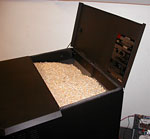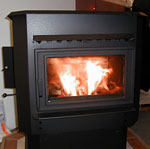Beating the High Cost of Energy - With Corn
By Erin Galbally
January 31, 2001
Part of MPR's online project, This Cold House
In the wake of spiking energy costs, corn has been redefined as a fossil fuel alternative. While the demand for ethanol is mounting, a less familiar kernel-driven energy source is gaining popularity.
Twice a day, dairy farmers Kelly and Joanne Ronnigen
dump a bucket full of golden kernels into the base of their corn-burning stove. The kernels are slowly funneled downward, toward the flame which burns around the clock. The stove represents the Ronnigens' primary heating source, generating enough heat to warm their rambling home during the coldest months of the year.
"This is actually our second stove," says Kelly Ronnigen. "We bought our first one in '95 and then they had some updates and we traded it in for a new one in '97. I guess it was at that time, when we were buying a lot of oil that was shipped in from Iraq, that we felt we might just as well burn our own fuel."
The Ronnigens estimate their heating costs would be close to six times higher if they had to rely on their previous heating source, liquid propane. Now their daily heat bill amounts to about $4, the cost of two bushels of corn.
"Corn would have to be $8.46 per bushel to be comparable to today's propane prices, so its not going to be too much of a problem I don't think," says Joanne Ronnigen.
The Ronnigens aren't the only people excited about burning corn. According to American Energy Systems, a major stove manufacturer in Hutchinson, sales of corn-burning stoves are up 500 percent so far this winter, and orders are backlogged through the summer. Steve Methke, the owner of a La Crosse stove retailer, says the increased demand is due to the soaring price of natural gas. Methke cautions while burning corn may be cheaper, stove owners need to use high quality kernels.
"It's a weird thing, but when corn is the cheapest it's probably the best fuel," says Methke. "That means it had a real good growing season. It's a high quality product, and it's inexpensive because there's a large quantity. Then on the opposite end, when it's a poor growing season it's going to be a lesser quality fuel for burning and the price is going to be higher."
Methke sells his stoves for just over $2,000, including installation. New owners can have the stove hooked up to a duct system like the Ronnigens, allowing warm air wider circulation. So far this winter, Methke's shop has watched sales jump. While this doesn't surprise Phil Smith of Minnesota's Energy Information Center, he predicts its popularity won't be lasting.
"Corn stoves appear and disappear in the market. They appeared in the '70s, they appeared in the '80s because of a price shock with fuel oil, and then they disappeared again," says Smith.
Smith says following the price of corn is like taking a ride on a roller coaster, and he points out corn isn't always the most convenient fuel source.
"One of the things you would want to look at if you're buying a device like that is its sustainability in the market. The price of corn to a farmer or the price of corn to a consumer to buy to burn is something that going to be changing all the time, and I don't know that that would be a value," Smith says.
The Ronnigens say the corn stove has proven its value, but agree it might not be the right home heating source for everyone. The stove requires daily maintenance, and they Ronnigens still use a back-up furnace when they go away. But as long as natural gas prices continue to climb, they expect more people, especially farmers, will make the switch.
Erin Galbally covers southeastern Minnesota for Minnesota Public Radio's Mainstreet unit. Reach her via e-mail at egalbally@mpr.org.
By Erin Galbally
January 31, 2001
Part of MPR's online project, This Cold House
|
|
RealAudio |
In the wake of spiking energy costs, corn has been redefined as a fossil fuel alternative. While the demand for ethanol is mounting, a less familiar kernel-driven energy source is gaining popularity.
| |
|
|
|
||
"This is actually our second stove," says Kelly Ronnigen. "We bought our first one in '95 and then they had some updates and we traded it in for a new one in '97. I guess it was at that time, when we were buying a lot of oil that was shipped in from Iraq, that we felt we might just as well burn our own fuel."
The Ronnigens estimate their heating costs would be close to six times higher if they had to rely on their previous heating source, liquid propane. Now their daily heat bill amounts to about $4, the cost of two bushels of corn.
"Corn would have to be $8.46 per bushel to be comparable to today's propane prices, so its not going to be too much of a problem I don't think," says Joanne Ronnigen.
The Ronnigens aren't the only people excited about burning corn. According to American Energy Systems, a major stove manufacturer in Hutchinson, sales of corn-burning stoves are up 500 percent so far this winter, and orders are backlogged through the summer. Steve Methke, the owner of a La Crosse stove retailer, says the increased demand is due to the soaring price of natural gas. Methke cautions while burning corn may be cheaper, stove owners need to use high quality kernels.
| |
|
|
|
||
Methke sells his stoves for just over $2,000, including installation. New owners can have the stove hooked up to a duct system like the Ronnigens, allowing warm air wider circulation. So far this winter, Methke's shop has watched sales jump. While this doesn't surprise Phil Smith of Minnesota's Energy Information Center, he predicts its popularity won't be lasting.
"Corn stoves appear and disappear in the market. They appeared in the '70s, they appeared in the '80s because of a price shock with fuel oil, and then they disappeared again," says Smith.
Smith says following the price of corn is like taking a ride on a roller coaster, and he points out corn isn't always the most convenient fuel source.
"One of the things you would want to look at if you're buying a device like that is its sustainability in the market. The price of corn to a farmer or the price of corn to a consumer to buy to burn is something that going to be changing all the time, and I don't know that that would be a value," Smith says.
The Ronnigens say the corn stove has proven its value, but agree it might not be the right home heating source for everyone. The stove requires daily maintenance, and they Ronnigens still use a back-up furnace when they go away. But as long as natural gas prices continue to climb, they expect more people, especially farmers, will make the switch.
Erin Galbally covers southeastern Minnesota for Minnesota Public Radio's Mainstreet unit. Reach her via e-mail at egalbally@mpr.org.


